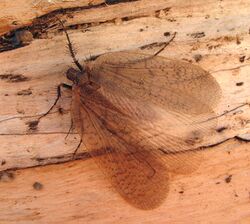Biology:Eomeropidae
From HandWiki
Short description: Family of insects
| Eomeropidae | |
|---|---|

| |
| Notiothauma reedi | |
| Scientific classification | |
| Domain: | Eukaryota |
| Kingdom: | Animalia |
| Phylum: | Arthropoda |
| Class: | Insecta |
| Order: | Mecoptera |
| Family: | Eomeropidae Cockerell 1909 |
| Genera | |
| |
Eomeropidae is a family of aberrant, flattened scorpionflies represented today by only a single living species, Notiothauma reedi, known from the Nothofagus forests in southern Chile , while all other recognized genera in the family are known only as fossils, with the earliest definitive fossil known from Liassic-aged strata,[1][2] and the youngest from Paleogene-aged strata.[1][3]
Genera
There are six extinct genera and one monotypic living genus which have been placed in Eomeropidae.
- †Eomerope. Cockerell 1909 This genus is known from Paleogene fossils from Eocene and Oligocene strata of North America, including the Allenby Formation and the Florissant Formation, and Paleocene to Oligocene strata of Russia .[3] Because N. reedi is not known in the fossil record, Eomerope is the youngest of the fossil genera, and has the widest range.
- †Burmothauma Zhang at al. 2022 B. eureka is known from the mid Cretaceous Burmese amber of Myanmar.[4]
- †Jurachorista. Soszyńska-Maj, et al., 2016 Known from the Early Jurassic, Sinemurian aged Charmouth Mudstone Formation of Dorset, England, is currently considered to be one of the oldest members of the family.[5]
- †Jurathauma. Zhang et al. 2011 J. xinjiangensis is known from the Early Jurassic (Sinemurian) Badaowan Formation of Xinjiang, China,[2] while J. simplex is known from the Middle Jurassic Daohugou Beds of Inner Mongolia, China.[6]
- Notiothauma. McLachlan, 1877 N. reedi is a remarkable species, flattened and extremely cockroach-like in appearance and habits. It is nocturnal, and scuttles on the forest floor, where it can be collected by laying trails of oatmeal. The larvae are still unknown. Because this is the last extant species of Eomeropidae, N. reedi can be characterized as a living fossil taxon.[3]
- †Tsuchingothauma. Ren and Shih 2005 T. shihi and T. gongi are both known from the Middle Jurassic Daohugou beds of China.[7][8]
- †Typhothauma Ren and Shih 2005 known from the Early Cretaceous Dabeigou Formation and Yixian Formation of China.[7][9]
Phylogeny
The proposed phylogenetic relationships within Eomeropidae based on Soszyńska-Maj et al 2016.[5]
| |||||||||||||||||||||||||||||||||||||
References
- ↑ 1.0 1.1 Zhang Junxia (2011). "A new fossil eomeropid (Insecta, Mecoptera) from the Jiulongshan Formation, Inner Mongolia, China". Zoosystema 33 (4): 443–450. doi:10.5252/z2011n4a2. https://zenodo.org/record/5166825.
- ↑ 2.0 2.1 Wang, Haoyi; Yao, Zongquan; Wang, Jun; Li, Qi; Yang, Jiangfeng (2023-08-29). "The first discovery of Eomeropidae (Insecta: Mecoptera) from the Lower Jurassic of northwestern China" (in en). Historical Biology: 1–5. doi:10.1080/08912963.2023.2250821. ISSN 0891-2963. https://www.tandfonline.com/doi/full/10.1080/08912963.2023.2250821.
- ↑ 3.0 3.1 3.2 Archibald, S. Bruce, Alexandr P. Rasnitsyn, and Mikhail A. Akhmetiev. "Ecology and distribution of Cenozoic Eomeropidae (Mecoptera), and a new species of Eomerope Cockerell from the Early Eocene McAbee locality, British Columbia, Canada." Annals of the Entomological Society of America 98.4 (2005): 503-514.
- ↑ Zhang, Kai; Zhao, Xiangdong; Bashkuev, Alexey S.; Xiao, Chuantao (2022-01-07). "The first eomeropid (Insecta, Mecoptera) from mid-Cretaceous Myanmar amber" (in en). Cretaceous Research 133: 105140. doi:10.1016/j.cretres.2022.105140. ISSN 0195-6671. https://www.sciencedirect.com/science/article/pii/S0195667122000040.
- ↑ 5.0 5.1 Soszyńska-Maj, Agnieszka; Krzemiński, Wiesław; Kopeć, Katarzyna; Coram, Robert A. (2016). "Phylogenetic relationships within the relict family Eomeropidae (Insecta, Mecoptera) based on the oldest fossil from the Early Jurassic (Sinemurian) of Dorset, southern England" (in en). Journal of Systematic Palaeontology 14 (12): 1025–1031. doi:10.1080/14772019.2016.1139007. ISSN 1477-2019. https://www.tandfonline.com/doi/full/10.1080/14772019.2016.1139007.
- ↑ Zhang J-X, Shih C-K, Petrulevičius JF, Ren D (2011) A new fossil eomeropid (Insecta, Mecoptera) from the Jiulongshan Formation, Inner Mongolia, China. Zoosystema 33(4): 443–450. doi:10.5252/z2011n4a2
- ↑ 7.0 7.1 D. Ren and C. K. Shih. 2005. The first discovery of fossil eomeropids from China (Insecta, Mecoptera). Acta Zootaxonomica Sinica 30(2):275-280
- ↑ Zhao, Xiangdong; Zhao, Xianye; Chen, Lei; Zhang, Qi; Wang, Bo (December 2019). "A new species of Eomeropidae (Insecta: Mecoptera) from the Middle Jurassic of China" (in en). Proceedings of the Geologists' Association 130 (6): 691–695. doi:10.1016/j.pgeola.2019.10.005. https://linkinghub.elsevier.com/retrieve/pii/S0016787819301233.
- ↑ J. X. Zhang, C. K. Shih, and D. Ren. 2012. A new fossil eomeropid (Insecta, Mecoptera) from the Yixian Formation, Liaoning, China. Acta Zootaxonomica Sinica 37:68-71
Wikidata ☰ Q1941583 entry
 |

